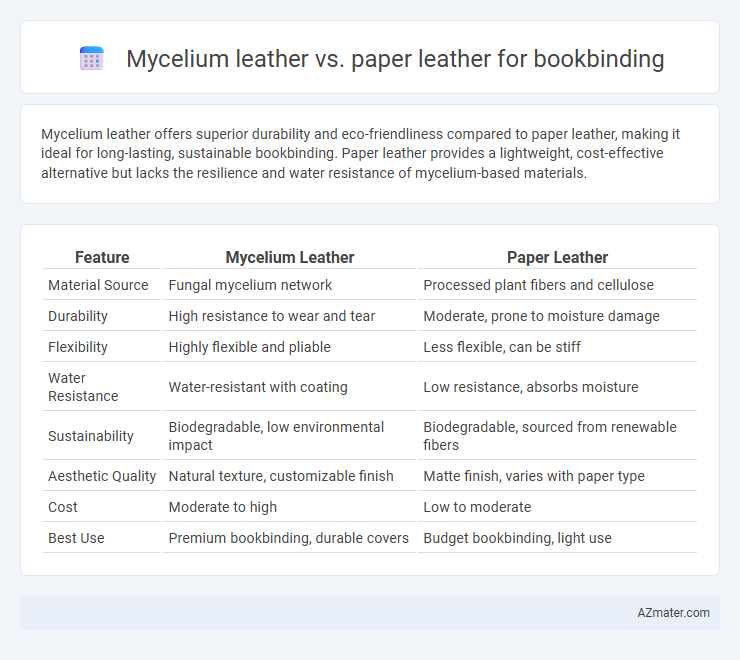Mycelium leather offers superior durability and eco-friendliness compared to paper leather, making it ideal for long-lasting, sustainable bookbinding. Paper leather provides a lightweight, cost-effective alternative but lacks the resilience and water resistance of mycelium-based materials.
Table of Comparison
| Feature | Mycelium Leather | Paper Leather |
|---|---|---|
| Material Source | Fungal mycelium network | Processed plant fibers and cellulose |
| Durability | High resistance to wear and tear | Moderate, prone to moisture damage |
| Flexibility | Highly flexible and pliable | Less flexible, can be stiff |
| Water Resistance | Water-resistant with coating | Low resistance, absorbs moisture |
| Sustainability | Biodegradable, low environmental impact | Biodegradable, sourced from renewable fibers |
| Aesthetic Quality | Natural texture, customizable finish | Matte finish, varies with paper type |
| Cost | Moderate to high | Low to moderate |
| Best Use | Premium bookbinding, durable covers | Budget bookbinding, light use |
Introduction to Sustainable Bookbinding Materials
Mycelium leather, derived from mushroom root systems, offers a biodegradable and eco-friendly alternative to traditional materials, making it ideal for sustainable bookbinding. Paper leather, composed of durable cellulose fibers, provides a renewable and recyclable option that mimics the texture and flexibility of genuine leather. Both materials align with environmentally conscious practices by reducing reliance on animal products and minimizing carbon footprints in bookbinding applications.
Understanding Mycelium Leather: Composition and Benefits
Mycelium leather, derived from the root structure of fungi, offers a sustainable and biodegradable alternative to traditional materials in bookbinding, characterized by its natural durability and flexibility. Its cellular composition mimics animal leather's texture, providing enhanced resilience against wear and moisture, making it ideal for long-lasting book covers. Compared to paper leather, mycelium leather demonstrates superior strength and environmental benefits, reducing deforestation and chemical waste in the production process.
What is Paper Leather? Production and Properties
Paper leather is an innovative material used in bookbinding, crafted by compressing and treating cellulose fibers derived from sustainable sources such as recycled paper or plant fibers. Its production involves bonding these fibers with natural resins or bio-based adhesives to create a durable, flexible, and eco-friendly alternative to traditional leather. Paper leather exhibits properties like water resistance, tear strength, and a textured surface, making it suitable for artisanal book covers while supporting sustainable practices.
Environmental Impact: Mycelium Leather vs Paper Leather
Mycelium leather, derived from fungal roots, offers a biodegradable alternative with low water consumption and minimal chemical use, significantly reducing environmental pollution compared to conventional materials. Paper leather, made from recycled fibers, also promotes sustainability by utilizing waste products and requiring less energy than traditional leather production, but it may involve chemical treatments that can impact biodegradability. Both materials support eco-friendly bookbinding by lowering carbon footprints, though mycelium leather's natural growth process provides a more regenerative and pollution-free lifecycle.
Durability Comparison: Longevity in Bookbinding
Mycelium leather exhibits superior durability compared to paper leather in bookbinding, providing enhanced resistance to wear and tear, moisture, and environmental factors, which extends the lifespan of bound books. Paper leather, while eco-friendly and lightweight, tends to degrade faster under frequent handling and exposure to humidity, resulting in shorter longevity. Mycelium's natural fibrous structure offers greater tensile strength and flexibility, making it a more reliable choice for durable, long-lasting book covers.
Aesthetic Qualities: Texture, Feel, and Appearance
Mycelium leather offers a rich, organic texture with subtle natural variations, giving book covers a unique, tactile feel that enhances the reading experience. Paper leather, often smoother and more uniform, provides a clean, minimalist aesthetic that can be ideal for modern or artistic book designs. Both materials present eco-friendly alternatives to traditional leather, but mycelium stands out with its earthy appearance and durability, while paper leather excels in lightweight flexibility and easy customization.
Flexibility and Workability for Bookbinders
Mycelium leather offers superior flexibility and durability, allowing bookbinders to create covers that withstand repeated handling and bending without cracking. Its natural fibrous structure supports easy molding and sewing, enhancing overall workability compared to paper leather. Paper leather, while eco-friendly and lightweight, tends to be less flexible and more prone to tearing, making it less ideal for projects requiring long-term resilience and intricate detailing.
Cost Analysis: Affordability and Accessibility
Mycelium leather, derived from mushroom fibers, generally incurs higher production costs due to specialized cultivation and processing methods, making it less affordable than paper leather for bookbinding projects. Paper leather, created from cellulose fibers and often recycled materials, offers a cost-effective and widely accessible alternative, especially suitable for budget-conscious artisans and publications. While mycelium leather appeals to eco-friendly markets seeking durability and uniqueness, paper leather remains the preferred choice for affordable, sustainable book covers with easier sourcing and lower material expenses.
Customization Options: Colors, Finishes, and Designs
Mycelium leather offers extensive customization options with a wide range of colors, natural textures, and finishes such as matte, glossy, or embossed, making it ideal for bespoke bookbinding projects. Paper leather, while eco-friendly, provides limited color choices and finishes, often requiring additional treatments to achieve similar aesthetics. The versatility of mycelium leather in dimension, pattern, and dye absorption enables more intricate and durable designs compared to the more rigid, less adaptable paper leather.
Choosing the Right Leather Alternative for Your Bookbinding Project
Mycelium leather offers exceptional durability, water resistance, and a unique natural texture, making it ideal for premium, long-lasting book covers. Paper leather provides a lightweight, eco-friendly option with excellent printability and flexibility, suitable for artistic or cost-effective projects. Selecting the right leather alternative depends on prioritizing factors such as longevity, environmental impact, tactile experience, and budget for your bookbinding project.

Infographic: Mycelium leather vs Paper leather for Bookbinding
 azmater.com
azmater.com